
The smartphone market grew 0.7% year over year in the second quarter of 2016, according to International Data Corporation’s Worldwide Mobile Phone Tracker. With this increased growth comes increased competition, and each smartphone manufacturer is working hard to attract and retain users with technological advances, sleek hardware and impressive operating systems (OS’s).
These operating systems have evolved significantly since their first iterations were launched into the competitive market more than a decade ago. Apple made its inaugural splash into the market in January 2007, with iPhone and iOS. The first-ever Android device, the T-Mobile G1, was released in October 2008, powered by Android 1.0. Last (but not least) to the OS release party was Windows Phone in February 2010.
Mobile usage has experienced a dramatic transformation since those first operating systems were released. In 2016, mobile and tablet internet usage exceeded that of desktops (51.3% versus 48.7%) for the first time worldwide, according to StatCounter. This data makes it clear that smartphones aren’t going anywhere. Indeed, users are relying on them more and more each year.
As technology evolves, along with your use of it, you may find yourself ready to upgrade your device to keep in touch, stay productive or simply to have the latest and greatest tech. But which type of smartphone, exactly, is the latest and greatest? And which operating system will give you the best experience?
It’s true that many people select their phones based on looks or a name, but there’s so much more to consider. Just as you wouldn’t buy a car without looking under the hood, don’t invest in a smartphone without researching its OS. The OS plays a key role in the experience you will having using your smartphone.
Here, we’ll focus on the three primary mobile operating systems: iOS, Android and Windows. We’ll discuss not only the pros and cons of the current systems, but also what we can look forward to with each of them in 2017.
What Is an OS?
Before you decide what the best mobile OS is — or what the best OS is for you — you might first want to know what an OS is at all! Put simply, it’s the primary program on a smartphone that manages all the other programs. Different developers have created different operating systems with different features, which makes understanding their similarities and differences all the more important.
Which Smartphone OS Should You Select?
Users generally feel quite passionate about their mobile phones and thus their operating systems. The exteriors of the newest smartphones are sleek on the outside, to be sure, but what’s on the inside? The operating system that powers your device is just as important to consider as the device’s looks.
What is the best mobile OS? Well, according to IDC, the Android OS market share for 2016 will be 85%, iOS will have a 14.3% share and Windows Phone will take a 0.4% market share. But popular doesn’t necessarily mean better.
Android, iOS and Windows OS have seen numerous changes since inception and have taken great strides in becoming more streamlined and user-friendly. As you navigate your options, consider your selection carefully. Switching from one OS to another in the future can cause considerable headaches. For example, you’ll need to buy apps all over again, since the apps for the different operating systems are not interchangeable. You’ll also need to adjust to varying limitations and different user interfaces within each OS.
Pros of the Three Major Operating Systems
While all three platforms have a very different behind-the-scenes approach, they all use a similarly structured interface that leverages the ease and flexibility of customized home screen pull-down notifications. Let’s review the best features of the iOS, Android and Windows operating systems. These features make up the “pros” of our comparison.
iOS Pros
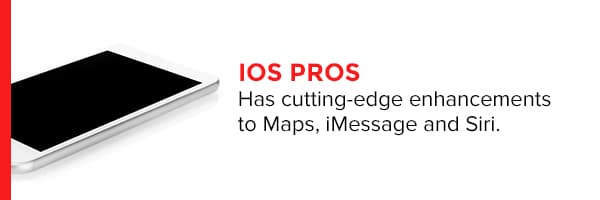
Personal and playful, iOS 10 — released in the fall of 2016 — has been called one of Apple’s biggest releases. With cutting-edge enhancements to Maps, iMessage and Siri, it’s no wonder this OS is so popular. Have you been asking yourself, “Should I switch to an iPhone?” If so, let’s review what makes this device great for users.
- User-friendly and simple to navigate, iOS may be best for those with limited computer experience or interest in customizing.
- Extensive content and apps are available through the App Store, and apps are often developed for and come to iOS first.
- iOS offers a uniform experience across all Apple applications and devices, such as with Apple TVs, MacBooks and iPads.
- It allows users to immediately download the latest iOS. Regardless of what carrier you’re using, software updates are available around the world simultaneously. Its latest iOS, 10, was released in the middle of September 2016 and is on 60% of devices so far..
- Apple continues to update older versions of its phones — it’s still updating 2011’s iPhone 4S.
- The limited selection of mobile devices that get access to iOS (only Apple’s devices) means that each software update can be thoroughly tested to ensure quality on the few devices it comes to. Other operating systems must deal with wide variations in hardware across dozens of devices, often leading to poor performance and unforeseen technical issues on at least a few of these smartphones.
Android Pros
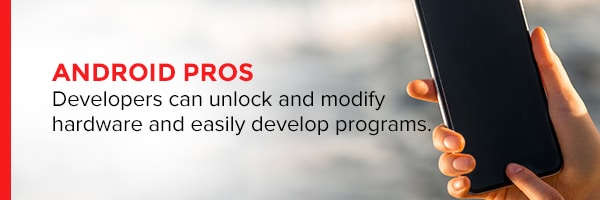
Owned by Google, the Android OS is a Java-coded, open-source OS. This means developers can unlock and modify hardware and easily develop programs. This makes it very popular with developers and users. Developers can create the content they want, and users benefit from the massive free content available.
The most current Android OS, 7.0 Nougat — releases are named after sweets — was released in August 2016. With a focus on productivity and security through file-based encryption, this latest OS helps users efficiently and quickly access what they need.
If you’re wondering whether you should switch to Android, you should consider the following:
- This OS is used on a wide range of devices — such as Samsung, LG, HTC, Sony and Motorola — and for a variety of price points.
- It’s the most flexible OS of the three discussed here.
- Android offers extensive apps available through Google Play and the Android Market, many of which are free.
- You have extensive control over nearly every aspect of the smartphone.
- Android OS unofficially allows alternative app stores and lets you install apps from your PC.
- There is a wide range of developer-built apps due to its open platform.
- The apps that tie in with Google’s online service see an effortless integration on Android. While the services are also available for iOS, they haven’t been as well-integrated. Because of Google support, it’s easy to stay in touch and in sync.
- This OS lets users freely customize almost every visual, functional and organizational aspect of the OS, including changing default texting and web browsing apps.
- Android uses widgets — quick, movable glances of an app’s data that are accessible from the home screen. Check out weather without opening the weather app, get a glimpse of sports scores without opening the ESPN app or look through news stories as they seamlessly appear on your home screen, thanks to your choice of news app widget.
Windows Pros
Windows 10 Mobile was released to the first smartphones in November 2015, and continued delivering releases to eligible devices in March 2016. Built with an emphasis on enhancing the user experience, the Windows 10 operating system offers the following pros:
- This OS is used on several different phones, such as Nokias and some Samsungs and HTCs.
- It has easy integration with common Microsoft Office products and productivity tools.
- Windows offers a unique, customizable, tile-based interface. Some are Live Tiles, which give you small bites of information — scrolling headlines, etc. — without making you open the app.
- You can use aggregators, known as “hubs,” to group like items. That means photos from multiple applications, such as Instagram, Facebook or the camera, are all grouped together in one easily accessed place.
- Windows 10 includes a mobile-optimized version of Internet Explorer for web browsing and Exchange for corporate email accounts.
- You have a user experience that’s highly customizable. Windows lets users modify not only the arrangement of tiles, but also the size. Users can increase the tile size to correspond with the app’s importance.
- You get a consistent experience with Microsoft 10 PCs and tablets, as well as with Xbox.
- You can turn your phone into a PC with the addition of Continuum. Connect a monitor, mouse and keyboard to phones with Windows 10 to complete this transformation.
- There are unique software features, such the Kid’s Corner. If you switch to a Windows phone, you can set up a safe place for your child to play with games, music, apps, videos and more without the risk of them accessing the important information on your phone. Each operating system is beginning to offer some sort of option for kids to use the smartphone safely, but Windows phones allow for some of the most flexibility in this area.
Cons of the Three Major Operating Systems
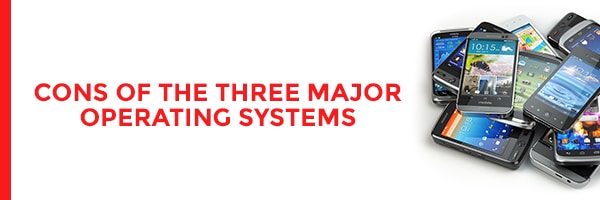
To fairly evaluate these operating systems, it’s also important to review their shortcomings. But remember: What one user views as a negative, another may view positively. The below is simply an overview of what objective reviewers have deemed to be OS deficiencies.
iOS Cons
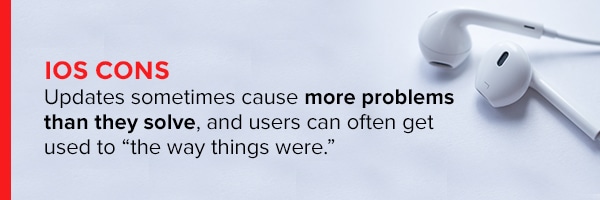
Updates sometimes cause more problems than they solve, and users can often get used to “the way things were.” When a major update happens, such as with iOS 10, pitfalls are bound to occur as users make the transition to the new system. Some of these negatives are not exclusive to a particular release — rather, they’re limitations of the platform itself.
- Older, refurbished smartphones that are limited on memory may come with iOS 7, limiting your accessibility and ability to use all the features the iPhone has to offer.
- With this platform, it’s difficult, if not impossible, to make high-level changes to your device, limiting your ability to customize it.
- The proprietary OS is not open-source, as Android is.
- Because Apple products aren’t cheap, it’s more difficult for the budget-conscious to take advantage of iOS.
- iOS lacks the app tray or drawer that Android and Windows features, which serves as an easy way to find downloaded items.
- While you can choose different apps to use — for example, a different browser — you can’t set any apps as the default.
- This iOS lacks the interactive tiles and widgets that provide at-a-glance information, although widgets were included on a small scale in iOS 10.
Android Cons
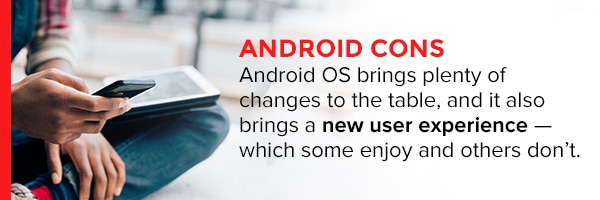
The latest release of the Android OS brings plenty of changes to the table, and it also brings a new user experience — which some enjoy and others don’t. Below is a quick rundown of the cons of the Android OS — both of the OS as a whole and specific to 7.0 Nougat.
- The OS won’t stop you from “bricking,” or breaking, your phone if you make an irrevocable change.
- Most Android phones don’t use a stock Android interface. Instead, many manufacturers layer their own interface on top, making for a wide range of experiences. This lack of consistency and fragmentation have been described as Android’s biggest downfall.
- It doesn’t immediately offer the latest OS version to users. Available since the end of August 2016, 7.0 Nougat is available to only 0.3% of Android devices. Updates come from the original equipment manufacturers rather than from Google.
- There may be app compatibility issues, because phones may be running vastly different versions of the OS that are incompatible with new apps.
- Alternative app stores increase your exposure to and risk for malware.
- The volume of apps in Google Play means it’s hard to search for and find the app you’re looking for. Many of the apps you will have to sort through simply aren’t very good due to the freedom that the platform offers and its lack of curation and regulation.
- For users who are using older Android versions, they’re susceptible to software vulnerabilities and bugs that have been corrected in subsequent versions.
- Its open-ended nature may require a deeper level of technical knowledge to get the most out of Android’s options and customizable features.
Windows Cons
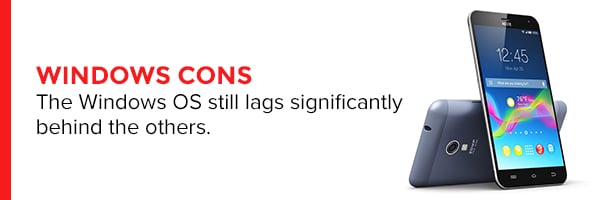
Considering switching to Windows Phone? Although growing in popularity, the Windows OS still lags significantly behind the others. What are its major drawbacks?
- Responsiveness can be sluggish, and the design appears to some as overly stylized. Like it or not, Windows 10 Phones have inconsistent OS design compared to previous versions.
- With approximately 600,000 apps, it lags considerably behind Android, with 2.2 million apps, and iOS, with 2 million apps.
- Even Microsoft apps like Skype are more likely to be found on competing operating systems and, because they have a larger market share, offer more features there than on Microsoft’s own Windows Phone.
- Battery performance with Windows Phones running Windows 10 is not very good compared to iOS and Android devices.
What Features Did Developers Roll Out in 2016?
Smartphone users regularly — and eagerly — await the newest OS changes, and 2016 didn’t disappoint. See if these updates will sway you towards one OS over another. Here’s what our top three rolled out in 2016:
iOS Updates
Users had the chance to upgrade to iOS 10. With no more swiping to unlock the phone — swiping right brings a redesigned notifications screen that incorporates limited widgets, and swiping left brings you to the camera — you can now access your home screen faster.
Many are relieved they can now remove Apple’s default apps. Messaging has become a lot more fun with a whole host of enhancements — including handwritten messages, fireworks and disappearing “ink” — plus, you can now choose who receives read receipts. If your car is equipped with CarPlay or a Bluetooth stereo, iOS 10 can help you find your parked car.
Third-party developers can also now develop features for Siri, so they can connect their apps to the digital assistant for things like booking transportation, making payments and starting workouts. Maps also received a facelift, offering a “Nearby” search that lets users search for locations — coffee, gas, restaurants — along a route. And iOS now offers the Night Shift feature that tints your screen at night to calm your brain and ease into sleep.
Android Updates
Android users saw 72 new emoji — bringing the total to more than 1,500 — with 7.0 Nougat and also gained the ability to use two or more languages at the same time. Are you a multitasker? The new OS lets you run two apps side by side, quickly switch between apps and see things in new dimensions: 3D and high-quality virtual reality. Although the split-screen feature has some compatibility issues — it doesn’t work with every app — that problem should be resolved as time goes on.
Windows Updates
Users of this OS experienced the anniversary update for Windows 10 Mobile, and it came with numerous features. From taking panoramic shots and accessing the camera from the lock screen to quick and easy browsing through the Microsoft Edge browser and access to Cortana — the personal digital assistant — getting things done has never been easier.
Some devices can now power a second screen — like a TV or monitor — through Continuum. And you can prioritize your notifications in the Action Center to ensure the most important ones appear at the top of the list. And the camera’s new Portrait mode uses background blur in portrait shots, making for professional-level shots.
What’s on the Horizon for 2017?
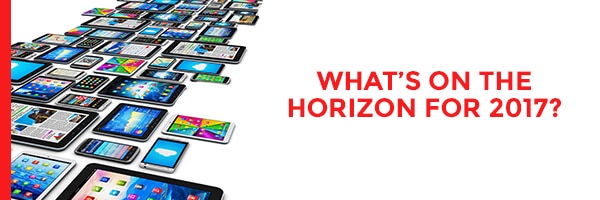
As the new year draws near, anticipation mounts for what 2017 will mean for technology — and for smartphones in particular.
Devices overall are expected to be faster, thinner, more flexible — literally! — and smarter. Their operating systems will be expected to keep pace. Speculation on what, if any, features will be included in future releases are simply that: speculation. Most companies haven’t released much information about what they have planned for 2017, but you can bet they’ve got some technological tricks hidden up their sleeves.
iOS
By January 1, 2017, all iOS apps must enable the App Transport Security feature, which forces apps to use HTTPS connections when connecting to the Web. This authenticates connections and encrypts data transmissions, protecting your data. This requirement is especially important for apps that deal with sensitive information, like banks and credit cards, but it’s beneficial for all apps.
The next iOS might also feature advanced biometric features, such as facial recognition or iris scanning, as well as further enhancements to Apple’s Taptic Engine, which may help facilitate the elimination of additional physical buttons.
Android
As Android continues to lead the market, accounting for 86.2% of new smartphone sales, development of apps and technology also continues. As outside apps are updated to support the new multi-window/split-screen function, the ability to drag and drop images, text, photos and more from one app to another holds great promise. While there is limited use of this feature now, the enhanced drag-and-drop feature will do a lot to make your smartphone more like your home-based PC.
Windows
There isn’t much news about changes to the next version of the Windows OS, but Skype app support for Windows Phones 8 and 8.1 will end in 2017, leaving nearly 80% of users in the lurch when it does.
What’s the Best OS for You?
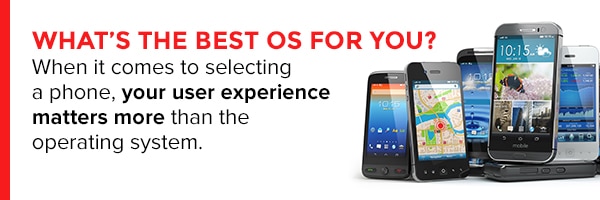
Android, Windows or iOS? When it comes to selecting a phone, your user experience matters more than the operating system. And as software development continues, you’ll see the field narrow and each OS become more competitive.
Should you switch operating systems? You may appreciate the seamless experience iOS offers, the flexibility of Android or the familiarity of Windows with your everyday PC. It might take some time to acclimate to a new system, so it may be best to stick with what you know.
Regardless of what you’re looking for, there’s an OS that meets your needs. Consider these questions to help you make the best choice:
- Do you mind learning a new OS? Many users never make a switch because they’re used to the way things work. While tapping and swiping may be common across most operating systems, you may need to learn a few new tricks if you switch.
- Do you have must-have apps? There are some big apps that are on Android, but not on iOS — and vice versa. From games to productivity, sometimes there aren’t alternatives. If you’re a budding musician, for example, you won’t find an Android equivalent to GarageBand. In addition, some apps come to iOS months before they come to other operating systems — if they ever do — but you won’t find a larger selection of apps than on the Google Play Store.
- Are you worried about malware? The open-source nature of Android may mean you’re more vulnerable to viruses, but such occurrences are rare. You can increase your safety with Android if you stick to official Google Play apps that have plenty of reviews.
Are You Ready to Make a Change?
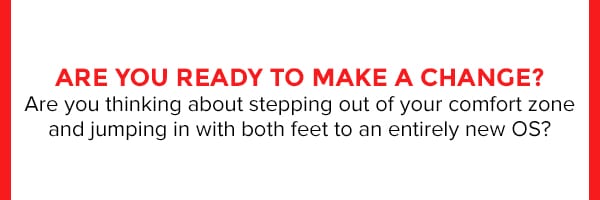
There are certainly many options when it comes to smartphone devices. Are you thinking about stepping out of your comfort zone and jumping in with both feet to an entirely new OS? As smartphone technology changes rapidly, your “old” phone might already be obsolete.
But it’s worth cash to you.
Whether you want to simply upgrade to the latest smartphone, are ready to make an operating system jump or just need extra cash, The Whiz Cells is here to help — and to make it easy. We’ll buy your old cell phone and even paying for shipping, keeping your old technology from the landfill and contributing to a greener planet. And the best part of all? You’ll get the money you need to upgrade your smartphone.
Simply sign up for a free Whiz Cells account, provide the answers to a few questions and receive an immediate cash offer for your phone. As a leading mobile recycling company, The Whiz Cells can provide you cash in as little as one business day through the Stupid Fast Payment option. You’ll be up and running with the latest technology in no time, calling others on your new smartphone to educate them about the pros and cons of the different operating systems.
Now that’s putting your money where your mouth is!
Sell Your Device